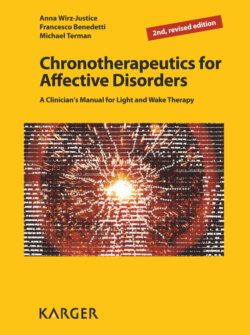Читать книгу Chronotherapeutics for Affective Disorders - M. Terman - Страница 7
На сайте Литреса книга снята с продажи.
Foreword
ОглавлениеSun worship has existed since the beginning of human life on earth. Light is our source of energy, of warmth, of spiritual and emotional sustenance. Light is the major synchroniser of the biological clock. It is no surprise to see light enter psychiatry as a practical treatment. Sleep deprivation has been investigated for four decades: the instantaneous, overnight remission of severe depression remains one of the most striking phenomena in psychiatry. Sleep deprivation did not enter the therapeutic armamentarium because patients usually relapse after recovery sleep, or even a nap. Now we have learned how to sustain the effect with morning light therapy, sleep phase advances and a variety of medications. Practical experience shows that major depression can indeed remit quickly and remain remitted even in otherwise refractory cases.
Here, we combine the elements of chronotherapeutics in a new synthesis. We hope that the methods will be widely explored on inpatient units, with the prospect of higher success rates, real remissions without ominous residual symptoms, and shorter hospital stays.
We designed this manual as a source book for clinicians. Readers can choose which category to read. We begin by presenting the insights of chronobiology and sleep research that provide the scientific basis, followed by an overview of the clinical literature, which justifies the treatments (Background). We then describe the principal therapeutic procedures with practical details for both inpatients and outpatients, and for younger and older individuals (Methods). Be-yond the core depressive disorders, we consider a broader range of current and potential applications (Indications), introduce melatonin and drugs that affect rhythms (Pharmacology), ending with a discussion of social issues that impinge on rhythmic structure and everyday well-being (Future Prospects).
Outpatients with affective disorders can learn to use light therapy – and even wake therapy – at home, but they must have directive coaching by the clinician. The current mode – ‘Go buy/try a light box, see if it works. (Period.)’ – is a formula for disappointment, and discredits the solid clinical research of more than 25 years. Clinicians need to learn the timing principles of the circadian clock’s response to light, and carefully dose the treatment as they would a medication.
Not to give up medication, though: the combination of light therapy with antidepressants can provide a potent enhancement over either one alone. The lucky minority – as we have seen in seasonal depression – will be able to taper drugs to discontinuation and remain euthymic under maintenance light monotherapy.
A new therapeutic paradigm often seeks a new generation of clinicians, and we especially encourage psychiatric residents to get these principles under their belt – to help the field identify limitations and refinements, and to view each case as an important learning experience for all of us. As we emphasize in the Manual, there are significant loose ends that can and should be resolved: new studies and feedback from the field are now our priority.
In 1988, a cloistered group of about 100 circadian rhythm aficionados and psychiatrists founded the Society for Light Treatment and Biological Rhythms (www.sltbr.org), with an annual summer scientific meeting including clinical trial reports, animal model studies, basic research in relevant photobiology, CME courses, contentious debates, and consensus development. If this Manual stimulates you, you should join SLTBR, follow its online news, and come to the annual meeting to share your experiences and help the field grow.
Also, we encourage readers to join a ‘members-only’ web forum on chronotherapeutics by accessing http://www.chronotherapeutics.org. With more than 200 members as of this second printing, the forum features discussion of the practical issues in using light therapy, sleep manipulations, melatonin and chronobiotics, ongoing studies, case consults, professional issues, and more.
For the interested lay public, an open website (www.cet.org), and a new book “Chronotherapy” by Michael Terman [1] provides useful information.
Anna Wirz-Justice, Basel
Francesco Benedetti, Milano
Michael Terman, New York
